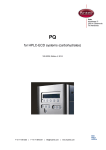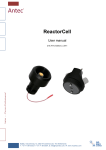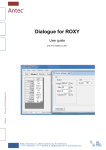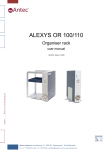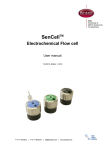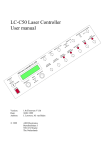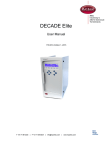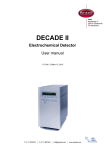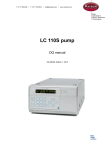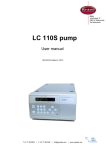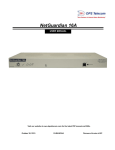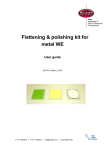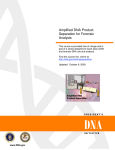Download 102_0010a_07
Transcript
FLEXCELL TM user manual Antec .... Proven Performance! 102.0010A, Edition 7, 2009 Antec Leyden bv, Industrieweg 12, 2382 NV Zoeterwoude, The Netherlands Phone: +31 71 5813333 ● fax: +31 71 5813334 ● [email protected] ● www.myantec.com INTRODUCTION Table of contents 1 Copyright ©2008 Antec Leyden. All rights reserved. Contents of this publication may not be reproduced in any form or by any means (including electronic storage and retrieval or translation into a foreign language) without prior agreement and written consent from the copyright of the owner. The information contained in this document is subject to change without notice. DECADE II, DECADE, INTRO, Sencell, Flexcell, Reactor, ISAAC, HyREF, LINK, ADF, DECADE Dialogue, DECADE II Dialogue are trademarks of Antec Leyden BV. Whatman™ (word and device) and Whatman™ (word only) are trademarks of Whatman lnternational Ltd. SOLVENT ® ® IFD™ and AQUEOUS IFD™ are trademarks of Arbor Technologies, Inc. Clarity , DataApex are ® trademarks of DataApex Ltd. Microsoft and Windows™ are trademarks of Microsoft Corporation. The information provided herein is believed to be reliable. Antec Leyden shall not be liable for errors contained herein or for incidental or consequential damages in connection with the furnishing, performance, or use of this manual. All use of the hardware or software shall be entirely at the user’s own risk. 2 Flexcell manual, edition 7 INTRODUCTION Table of contents 3 WEEE directive All equipment of Antec Leyden which are subjected to the WEEE directive shipped after August 13, 2005 are compliant with the WEEE marking requirements. Such products are labelled with the “crossed out wheelie”, depicted on the left site. The symbol on the product indicates that the product must not be disposed as unsorted municipality waste. Collection & recycling information Please ship the part back to the manufacturer (Antec Leyden, the Netherlands) at the end-of-life time of the product. The manufacturer will take care of the proper disposal and recycling of the instrument at its facilities. Shipping address for the end-of-life products: Antec Leyden Industrieweg 12 2382NV Zoeterwoude The Netherlands In case of questions, or if further information is required about the collection & recycling procedure, please contact your local distributor. ROHS directive Our instruments are currently exempt from the RoHS directive because they fall under WEEE Annex IA categories 8 and 9, which includes medical devices and monitoring and control instruments. Nevertheless, we have taken steps to eliminate all restricted substances from our products. Intended use For research purposes only. While clinical applications may be shown, this instrument /part is not tested by the manufacturer to comply with the In Vitro Diagnostics Directive. Antec Leyden is an ISO 9001:2000 certified company. 4 Flexcell manual, edition 7 Symbols The following pictograms are used in this user manual: Warning/caution sign. It calls attention to a procedure or practice which, if not adhered to, could result in severe injury or damage to parts or all of the equipment. Do not proceed beyond a warning sign until the indicated conditions are fully understood and met. The attention sign signals relevant information. Read this information, as it might be helpful. The note sign signals additional information. It provides advice or a suggestion that may support you in using the equipment. INTRODUCTION Table of contents 5 Safety practices Perform periodic leak checks on LC tubing and cell connections. Do not allow flammable and/or toxic solvents to accumulate. Follow a regulated, approved waste disposal program. Never dispose of such products through the municipal sewage system. LC equipments should be used by trained laboratory personnel only. Use proper eye and skin protection when working with solvents. Additional safety requirements or protection may be necessary depending on the chemicals used in combination with this equipment. Make sure that you understand the hazards associated with the chemicals used and take appropriate measures with regards to safety and protection. Use of this product outside the scope of this guide may present a hazard and can lead to personal injury. Spare parts and service availability Manufacturer provides operational spare parts of the instrument and current accessories for a period of five years after shipment of the final production run of the instrument. Spare parts will be available after this five years period on an ‘as available’ basis. Manufacturer provides a variety of services to support her customers after warranty expiration. Repair service can be provided on a time and material basis. Contact your local supplier for servicing. Technical support and training can be provided by qualified chemists on both contractual or as-needed basis. 6 Flexcell manual, edition 7 INTRODUCTION Table of contents Table of contents I N T R O D U C T I O N WEEE directive 3 ROHS directive 3 Intended use 3 Symbols 4 Safety practices 5 Spare parts and service availability 5 Table of contents 7 The electrochemical flow cell 9 Introduction 9 Three-electrode configuration 10 HyREF™ reference electrode 11 I/E curves 11 Example 12 ISAAC™ reference electrode 12 Salt bridge Ag/AgCl reference electrode 14 Working electrodes 14 Installation 17 General precautions 17 Installation of Flexcell 17 Maintenance 21 HyREF & ISAAC 21 Ag/AgCl salt bridge 21 Saturation and air bubbles 21 Material 22 Procedure 22 Maintenance of the cotton wool frit 23 Working electrode maintenance 25 Decreased flow cell performance 25 Disassembly of the flow cell 26 Polishing 27 Assembly of the flow cell 28 Maintenance Magic Diamond electrode 29 Storage 31 7 8 Flexcell manual, edition 7 CHAPTER 1 The electrochemical flow cell C H A P T E R 1 The electrochemical flow cell Introduction The Flexcell™ has been developed for analysis in standard and microbore LC-EC. The use of an exchangeable working electrode offers maximum flexibility for multiple applications requiring different working electrode materials. Also in applications where the working electrode material is electrochemically ‘consumed’ this is advantageous. Exchanging the working electrode only takes a minute. The Flexcell has an effective volume of 0.5 µl and is available with a working electrode of glassy carbon, Magic DiamondTM (MD), platinum, gold, silver or copper. A HyREF™ reference electrode (REF) is standard supplied. For special applications two other reference electrodes are available: a salt-bridge Ag/AgCl reference electrode filled with saturated KCl and an In-Situ Ag/AgCl (ISAAC™) reference electrode. The construction of the Flexcell is such that both fluid connections can be used as in- or outlet. Fig. 1. Flexcell. Note that for use of a Magic DiamondTM electrode a detector with an extended Ec range (-5 / +5 V) is required: DECADE II 5V SCC (p/n 171.0035V) or DECADE II 5V DCC (171.0038V). Please contact you local supplier for additional information or advice. 9 10 Flexcell manual, edition 7 Three-electrode configuration In the Flexcell a three-electrode configuration is used (Fig. 2). The working potential is set between the working electrode and the auxiliary electrode (AUX). The auxiliary electrode is kept at a precisely defined reference electrode potential by means of the so-called voltage clamp. This is an electronic feed back circuit that compensates for polarisation effects at the electrodes. At the working electrode, which is kept at virtual ground, the electrochemical reaction takes place, i.e. electrons are transferred at the working electrode. This results in an electrical current to the I/E converter, which is a special type of operational amplifier. The output voltage can be measured by an integrator or recorder. Fig. 2. Schematic representation of an electrochemical cell with a threeelectrode configuration. Essentially, for the oxidation or reduction reaction it would be sufficient to use only two electrodes. However, the three-electrode configuration has several advantages over a two-electrode configuration. If the working potential would be applied only over an auxiliary electrode versus the working electrode (without reference electrode), the working potential would continuously change due to polarisation effects at the electrodes, resulting in highly unstable working conditions. If the working potential would be applied only over the reference electrode versus the working electrode (without auxiliary electrode), the working potential would be very well defined. However, the potential of a reference CHAPTER 1 The electrochemical flow cell 11 electrode is only well defined if the current drawn is extremely low (picoamperes) resulting in a very limited dynamic range. A three-electrode configuration combines the best of both configurations. The reference electrode stabilises the working potential and the auxiliary electrode can supply high currents. This results in the tremendous dynamic range of a three-electrode system. HyREF™ reference electrode The Flexcell is standard equipped with a maintenance free HyREF. The HyREF is fully comparable with the standard Ag/AgCl REF as to baseline stability and S/N ratio. An important characteristic of the HyREF is the pH dependence of the reference potential. It is important to realise that if the pH of the mobile phase is changed, also the optimum working potential changes. In such case it is advisable to construct a hydrodynamic or scanning voltammogram. I/E curves The reference potential of an Ag/AgCl or HyREF are different (Fig. 3). pH 3.3 6.2 7.5 11.8 400 E (V) 300 200 100 E (V) 232 130 90 0 0 0 5 10 15 pH Fig. 3. Potential difference between HyREF and Ag/AgCl REF versus pH. So, if an Ag/AgCl REF is replaced by a HyREF, the pH effect on HyREF, compared to Ag/AgCl must be taken into account. The pH-voltage relation is described by: EHyREF = EAg/AgCl - 328 + 29.9 pH (1) 12 Flexcell manual, edition 7 Example If an Ag/AgCl REF is exchanged for a HyREF a working potential of 800 mV (vs. Ag/AgCl) at pH 3, has to be changed to: EHyREF = 800 - 328 + 29.9*3 = 560 mV (vs. HyREF) As a rule of thumb, the working potential should be chosen such that a similar background signal (I-cell) is measured with the HyREF as in using the Ag/AgCl REF. The VT03 flow cell is available with an HYREF (in situ Ag/AgCl) reference electrode, a salt bridge Ag/AgCl reference electrode and a HyREF reference electrode. ISAAC™ reference electrode The ISAAC reference electrode is in direct contact with the mobile phase which contains chloride ions. The chloride concentration determines the potential, therefore each time a fresh mobile phase is prepared it should contain exactly the same concentration of chloride ions. The standard electrode potential of the Ag/AgCl electrode (in 1.0 mol/l Clsolution) for the following half-reaction is defined as E0: AgCl(s) + e- <=> Ag(s) + Cl- E0 = 0.222 V The potential of the REF is dependent from the chloride concentration as described by the following equation: Ecell = EoAgCl - (RT / F) ln [Cl-] where R is the gas constant (8.314 Jmol-1K-1), T is the absolute temperature (293 K) and F is the Faraday constant (96485 Cmol-1). The potential of the ISAAC at 2 mmol/l KCl is 379 mV (Table I). The potential difference (dE) between the saturated KCl Ag/AgCl reference electrode and the HYREF is 189 mV. If an application is running at 800 mV (vs. Ag/AgCl with sat’d KCl), the potential setting using the ISAAC should be 611 mV (vs. Ag/AgCl in 2mmol/l KCl). CHAPTER 1 The electrochemical flow cell 13 Fig. 4. Dependence of the Ag/AgCl REF potential on the chloride concentration. Table I. Potential of the Ag/AgCl reference electrode, dE is the potential difference with EAg/AgCl in saturated KCl. Cl- E Ag/AgCl (mV) (mmol/l) 3500 190 2500 199 1500 212 500 240 100 280 20 321 10 338 8 344 6 351 4 361 2 379 1 396 0.5 414 dE (mV) 0 8 21 49 90 130 148 154 161 171 189 206 224 The addition of chloride to the mobile phase has a few restrictions. For example, the ISAAC is not recommended at a high working potential (> 1.2 V vs. Ag/AgCl in 2 mmol/l KCl) because Cl- is oxidised and contributes to the background current. In ion chromatography the addition of Cl- may lead to undesired chromatographic changes. In case of a silver working electrode, the addition of Cl- to the mobile phase will cause formation of an AgCl coating on the working electrode leading to inactivation. At high pH or high modifier concentrations the ISAAC is less suitable and a HyREF is recommended. 14 Flexcell manual, edition 7 Salt bridge Ag/AgCl reference electrode The reference electrode of the Ag/AgCl type with salt bridge consists of a silver rod, coated with solid AgCl, immersed in a solution of saturated KCl, containing KCl crystals. Electrical contact with the other electrodes in the flow cell is made through a salt bridge consisting of a wetted cotton wool frit, which is electrically conducting and slows down leakage of KCl. This REF for the VT03 flow cell is factory filled with KCl. For certain applications another chloride salt is to be preferred. In case of perchlorate containing mobile phases, sodium chloride is mandatory, because potassium perchlorate precipitates and will clog the cotton wool frit. At high modifier percentages, the REF must be filled with lithium chloride for similar reasons. Fig. 5. Schematic representation of the Ag/AgCl reference electrode. Working electrodes Electrochemical detection puts high demands on the working electrode material. The working electrode should be made of a (electro-)chemically inert material. Furthermore, to avoid an irregular flow profile over the electrode, it should have a very well defined surface. Finally, it is important that the analyte of interest can be oxidised (or reduced) with favourable I/E characteristics. This in fact means that a high signal must be obtained at a low working potential. For most applications glassy carbon will be the working electrode material of choice. Under certain circumstances other materials are required. CHAPTER 1 The electrochemical flow cell 15 Table II. Working potential limits and application area for different working electrode (WE) materials. WE material Glassy carbon Magic diamond* Gold Platinum Silver Nickel Copper potential limits vs. Ag/AgCl (V) alkaline acidic -1.50 +0.60 -1.25 -0.90 -1.20 - +0.75 +0.65 +0.10 +0.60 +0.20 -0.80 -1.00 -0.35 -0.20 -0.55 - application +1.30 +2.00 +1.10 +1.30 +0.40 +0.40 +0.60 catecholamines Iodide, disulfides carbohydrates alcohols, glycols halides, cyanide amino acids, carbohydrates amino acids, carbohydrates For example, for the analysis of iodide a silver working electrode can be used. At the silver working electrode the following oxidation reaction occurs for iodide: Ag + I- → AgI + eThis reaction already occurs even at a very low working potential (1 mV !), which results in an extremely high selectivity. This allows the determination of iodide in urine samples with virtually no sample pre-treatment. Another consideration in choosing a working electrode is the oxidation or reduction of mobile phase constituents or working electrode material, that occurs when the potential exceeds the limits as given in Table II. At high positive working potentials the water in the mobile phase electrolyses and results in an strong increase of the background current and noise. Formation of metal oxides, resulting in an increase in background current is a limiting factor for metal electrodes. Glassy carbon and platinum have the highest positive potential limits and are therefore often used in oxidative ECD. For negative potentials the use of platinum electrodes is strongly limited by the ease of reducing hydrogen ions to hydrogen gas. Magic DiamondTM is a new working electrode material available for the Flexcell. The MD electrode consisting of an ultra-thin film of doped diamond material deposited on a Si wafer. The special properties of doped diamond electrodes, such as a large potential window, their inertness and excellent response stability, makes them well suited for electro-analytical application. For example, Magic Diamond can be employed for the analysis of thiols, disulfides, iodide and other components were electrode fouling is an issue, such as phenols. 16 Flexcell manual, edition 7 CHAPTER 2 Installation C H A P T E R 17 2 Installation General precautions 1. Always make sure that the surfaces of the spacer and working electrode are dry and free from particulate matter before assembling the cell. Clean fingerprints from spacer and electrode surfaces with acetone or methanol. 2. If the auxiliary electrode needs to be cleaned, wipe the surface careful with a soft tissue soaked in acetone or methanol. Do not apply force you may damage the electrode surface. 3. Make sure that the working electrode has a mirror-like appearance before re-assembling the flow cell. The Magic Diamond electrode is an exception. This particular WE electrode has a crystalline blue/gray surface structure. This electrode must not be polished mechanically. Polishing the MD electrode surface will damage the electrode and lead to loss of performance. Follow the specific maintenance instructions in chapter 3. 4. If the flow cell is not in use and removed out of the LC system, we recommend that you disassemble the cell and clean all surfaces (turn off the cell first). Installation of Flexcell The flow cell is assembled properly when it arrives. Make sure that all marked items on the checklist are included. Never switch on the flow cell if: • the (black, red and blue) cell cable is not correctly connected, • the cell is only partly (or not at all) filled with buffer, because damage to the working electrode or the electronics may occur. 18 Flexcell manual, edition 7 Use proper eye and skin protection when working with solvents. The ISAAC reference electrode requires 2 mmole/l chloride ions (KCl or NaCl) in the mobile phase. Add and equilibrate before installation of the HyREF. See manual electrochemical detector for optimisation of working potential 1. Remove the reference electrode from the inlet block (Fig. 9). 2. Install a suitable length of sharply cut 0.15 mm ID PEEK tubing between the column and the flow cell. 3. Turn on the HPLC pump. Place some tissues as you probably will spill some mobile phase during this mounting procedure. Connect the column outlet to the flow cell inlet, using one of the fingertights supplied and tighten it carefully. Over-tightening affects the flow through the tubing (turbulence) and decreases the flow cell performance. red LC out AUX blue WORK REF black LC in Fig. 6. Flow cell and cell cable (for DECADE II™). WORK, AUX and REF are connected using the red, blue and black lead of the cell cable, respectively. Use only our factory-supplied fingertights in the flow cell, others may cause serious damage! 3. Install a suitable length of sharply cut 0.15 mm ID PEEK tubing to the flow cell outlet. 4. Close the outlet tubing (by finger) and force the mobile phase in the reference electrode reservoir. 5. Install the reference electrode in the reservoir, without including bubbles. CHAPTER 2 Installation 19 In case of a Salt bridge REF: Check the REF visually for air bubbles and saturation with KCl. Some KCl crystals should be visible. When no crystals are visible or air bubbles are trapped the REF needs maintenance (chapter 3). To prevent drying-out the REF is sealed with a cap on arrival. Remove the cap. Tighten the black swivel of the REF, a small droplet should appear at the cotton-wool frit. Do not remove this droplet because it ensures proper contact of the REF with the mobile phase. 6. Place the cell under an angle of 45° in the DECADE II™ controller with the outlet facing the top side prevent entrapment of bubbles. Connect the cell cable as illustrated in Fig. 6. The maximum detection stability is attained when not only the flow cell, but also the HPLC column, the injector and a pulse damper are incorporated in the controller. The controller has an integrated Faraday cage and an accurately temperature-controlled oven compartment which ensures stable working conditions. Installing the flow cell and column within such a controlled environment is the minimum requirement for high-quality LC-EC trace analyses. 20 Flexcell manual, edition 7 CHAPTER 3 Maintenance C H A P T E R 21 3 Maintenance HyREF & ISAAC The HyREF and ISAAC reference electrode are in principle maintenance free. If not in use they should be stored dry after disassembling the flow cell. Ag/AgCl salt bridge Three aspects determine the proper function of an Ag/AgCl reference electrode. 1. The chloride concentration must be kept at a strictly fixed level. This is best guaranteed by using a saturated chloride salt solution at a constant temperature. 2. The salt bridge must allow proper electrical contact with the mobile phase. The higher the leakage through the frit the better the conduction. This conflicts with the previous point. 3. Air bubbles inside or close to the salt bridge will lead to instability of the three-electrode configuration. Because of their extreme compressibility, changes in conductivity and the ionic equilibrium of the REF occur. This increases the noise considerably. The REF is factory filled with KCl unless specified otherwise. Other chloride salts should be used when the mobile phase contains perchlorate (use NaCl) or a high percentage of organic modifier (use LiCl). Saturation and air bubbles After prolonged use the salt bridge in the REF will not be saturated any more, which usually leads to a poor reproducibility in electrochemical detection. The potential of the REF is determined by the chloride concentration. If the salt bridge is not saturated and the KCl concentration changes: 1. the noise in the system will slowly but continuously increase, 2. the background current will increase, 3. sensitivity for movements and pump noise will increase. If an air bubble is trapped in the salt bridge or in the cotton plug that separates the salt bridge and the mobile phase the flow cell becomes extremely 22 Flexcell manual, edition 7 sensitive towards flow fluctuations and vibrations. This is caused by the high compressibility of the trapped air. Check your REF regularly. If you do not see chloride salt crystals or if you see air bubbles, your REF needs maintenance. Material 1. An over-saturated and thoroughly degassed KCl solution. 2. A stainless steel rod of about 5 cm length and a diameter of 1 mm (e.g. a 1 mm drill). 3. Ordinary cotton wool. Procedure Use proper eye and skin protection when working with solvents. 1. 2. 3. 4. 5. 6. 7. Turn the cell OFF on the controller. Stop the HPLC pump. Disconnect the cell from the controller. Remove the REF from the inlet block. Disassemble the REF by unscrewing the black swivel Fig. 7). Inspect the Vyton rings for wearing and especially the cotton wool frit, replace if required (see below). Fig. 7. Exploded view of the reference electrode. The arrow indicates the tip of the AgCl coated silver rod. See Table III for description and numbers. 8. Remove the remaining KCl from the salt bridge. 9. Clean all parts with demi-water. 10. The Ag/AgCl electrode must be cleaned if the silver on the tip ( CHAPTER 3 Maintenance 23 11. Fig. 7, arrow) has a non-metallic appearance by gently grinding it on sanding paper; also the AgCl can be gently resurfaced in this way. 12. The frit in the salt bridge ensures electrical contact with the buffer. If the frit is discoloured or dried out, it has to be renewed. In that case continue with ‘Maintenance of the cotton wool frit’ step 1. Otherwise, continue with step 7. Table III. REF parts and description. Item Description 1 2 3 4 5 6 REF cap for storage and shipment Vyton ring (large) Salt bridge Vyton ring (small) Ag/AgCl electrode + fitting Swivel for REF Maintenance of the cotton wool frit Use proper eye and skin protection when working with solvents. 1. Use a drill of ± 1 mm (0.039 inch) to push out the frit from the outside (Fig. 8). Be careful not to damage the frit constriction (first arrow). Fig. 8. Pushing the cotton wool frit out. 2. Clean the salt bridge thoroughly by tap water and demi-water respectively. 3. Saturate a small piece of cotton-wool in saturated KCl to exclude trapping of air within the wool. 4. Plug the salt bridge with the REF cap and fill the salt bridge for ± 50%. 24 Flexcell manual, edition 7 5. Use the drill to pack the wool from above through the KCl solution into the channel of the salt bridge, compress it firmly, but not too much, since electrical conduction is essential. 6. Remove the cap. 7. Fill the salt bridge completely, add some KCl crystals out of a saturated solution to ensure prolonged saturation. 8. Place the small Vyton ring over the Ag/AgCl electrode and slowly insert it, in an angle of 45o into the salt bridge. Make sure not to enclose an air bubble. 9. Tighten the black swivel such that a small droplet appears at the end of the salt bridge, but do not over-tighten the swivel. 10. Flush the complete, mounted REF with demi-water, dry it with a tissue, but keep the cotton wool frit soaked. 11. Carefully inspect the REF visually for trapped air bubbles, otherwise remove them (go back to step 7 or if necessary step 1). When not in use, please store the REF with the cotton wool frit immersed in a saturated KCl solution to prevent drying out. CHAPTER 3 Maintenance 25 Working electrode maintenance Cleaning of the working electrode is necessary if the electrode surface has been electrochemically changed. This may be due to fouling by oxidation (reduction) reaction products. Excessively high currents also may change the electrode surface. This is noticed by a strongly decreased sensitivity after prolonged use. Hy-REF reference electrode auxiliary electrode inlet block retaining ring 50 µm spacer working electrode disk Working electrode assembly electrode swivel nut Fig. 9. Exploded diagram of Flexcell. Decreased flow cell performance Several actions can be taken at decreased flow cell performance. Avoid unnecessary polishing, take the next step only if the previous was not successful. 1. Wiping the electrode surface with a tissue wetted with methanol or acetone 2. Polishing the electrode surface. Only apply polishing on Metal and GC electrode only. Do not polish Magic Diamond electrodes, for Diamond 26 Flexcell manual, edition 7 electrodes follow the (re)activation procedure described in a separate section of this manual. Disassembly of the flow cell If the working electrode needs maintenance, the cell has to be disassembled (see Fig. 9). Before disassembling the flow cell read General precautions. 1. Switch off the flow cell and HPLC pump and disconnect both fingertights. 2. Unscrew the electrode swivel nut and take out the working electrode assembly. 3. Remove the retaining ring. 4. Take out the WE contact (Fig. 10). 5. Clean and dry the spacer. 6. Clean or polish the WE as described below. 7. Note that the WE has only 1 side with a mirror-like surface. This side is facing the LC liquid and should be polished. Fig. 10. Electrode assembly. The working electrode is fitted on the electrode shaft with electrode retaining ring (1) and held in place by a silicon electrode holder (2). Use proper eye and skin protection when working with solvents. CHAPTER 3 Maintenance 27 Polishing The polishing procedure is for metal & GC working electrodes only. Do not polish the thin-film Magic Diamond electrodes, it will lead to damage of the electrode surface and a loss of performance. For Magic Diamond electrodes follow the activation procedure described in a separate section of this manual. 1. Shake diamond slurry thoroughly before use!! 2. Rinse the polishing disc with demi water before applying the diamond slurry! 3. Apply a small amount of slurry on the wetted polishing disc, usually one drop is sufficient. 4. Put the working electrode with the face down on the disc and polish the electrode with a ‘figure 8’ motion for about one minute. Apply only gentle pressure with one finger. 5. Clean the electrode with an ethanol-wetted tissue and check the surface visually; repeat the procedure if necessary. 6. Reassemble the cell. 7. Clean the polishing disc with demi water. 8. Store the polishing disc dust free in its plastic bag. There is a dedicated flattening and polishing kit for metal WE available (p/n 250.1045). This is a tailor-made kit to flatten and polish a metal Working Electrode (WE) disc of a Flexcell. It consists of a three stage flattening-polishing procedure. Steps: [1] [2] [3] Flattening step, coarse (30 um flattening plate) Flattening step, fine (12 um flattening plate) Polishing step, fine (polishing disk with diamond slurry) The procedure enables the user to restore the flat metal WE surface again in a reproducible way. 28 Flexcell manual, edition 7 Assembly of the flow cell 1. Make sure that the surface of the spacer and inlet block is dry and free from particulate matter. Clean fingerprints from spacer with acetone or methanol. Always assemble the two halves of the cell body first, prior to fitting the working electrode assembly. To prevent the spacer from moving keep the flow cell with the inlet block down as illustrated in Fig. 7. 2. Take the working electrode disk and press it in its silicone holder 3. Make sure that the surface of the working electrode is dry and free from particulate matter. Clean fingerprints from electrode surface with acetone or methanol. 4. Put the spacer in position and install the retaining ring. 5. Install the working electrode assembly. 6. Close the outlet tubing (by finger) and force the mobile phase in the reference electrode reservoir. 7. Install the reference electrode without including bubbles. 8. Place the cell with the outlet on top to prevent entrapment of bubbles. Connect the cell cable as illustrated in Fig. 6. 9. Carefully tighten the fingertights. Overtightening will damage the inlet block. The surface of the inlet block, working electrode and spacer should be dry when assembling the flow cell. If not, the noise in LC-EC will increase considerably. CHAPTER 3 Maintenance 29 Working electrode assembly electrode swivel nut retaining ring 50 µm spacer Fig. 11. Assembling the flow cell: first fit the spacer and the retaining ring, then WE assembly and the electrode swivel nut. TM Maintenance Magic Diamond electrode The Magic Diamond working electrode (see Fig. 12) consists of an ultra-thin crystalline Diamond layer deposited on top of a Si substrate. Therefore, such electrode cannot be polished to restore the electrode surface in case of loss of sensitivity due to fouling. An effective method to restore the detection performance is by electrochemically reactivation of the electrode surface under acidic conditions. Fig. 12. Working electrode assembly with Magic Diamond electrode . 30 Flexcell manual, edition 7 Electrochemical reactivation procedure: 1. Disassemble the flexcell as described on page 26. Keep the MD electrode disc fixed inside the working electrode assembly. 2. Wipe the electrode surface with a tissue wetted with methanol or acetone and subsequently with demi water to clean the electrode surface. Under all circumstances try to avoid direct contact of the electrode surface with fingers. The skin contains fatty substances which will foul the electrode. 3. Assemble the flexcell as described in the previous section. 4. Remove the column from the LC system and all other non-acid resistant part, such as inline filters (Whatman) etc. 5. Prepare a mobile phase of 0.5 M Nitric acid (HNO3) and flush it through the LC system with a flow rate of 250 μL/min. When all parts are flushed install and prime the flowcell with the acidic solution. Make sure that all parts that are not acid-resistant such as: nylon inlet filters, column are not connected in the LC system during this step. 6. Set the DECADE II 5V detector in SCAN mode with the following settings: E1 = -3.00 Volt, E2 = +3 Volt, Scan rate: 50 mV/s, scan cycle: continuous and range 200 uA/V. 7. Start scanning under acidic conditions for 1 hours. 8. After scanning switch of flow cell, replace the mobile phase by HPLC grade water and flush the cell to remove the acidic solution. After the scan procedure keep the flowcell assembled, do not open it for inspection. The spacer in the cell, which determines the flow path, is diamond-shaped and only that specific surface of the Magic Diamond electrode is reactivated. Disassembling and assembling the cell again could result in loss of sensitivity due to a misalignment of the spacer with respect to the reactivated electrode area. 9. Reinstall the column and flush the system and cell with mobile phase. 10. Switch on the flowcell, let the current stabilize and start up measurements again. In the case there is no significant sensitivity improvement observed, repeat step 1 to 10 and increase the total scan time (step 7). CHAPTER 3 Maintenance 31 One can also try to perform the activation procedure under the mobile phase conditions of the application. Furthermore, in literature anodic treatments are reported (for example the application of a static potential of + 3 Volt vs. Ag/AgCl for 5 – 10 minutes) to restore the electrode response, for example for the analysis of chloro-phenols. Such procedure could be executed as an alternative, if the above-mentioned procedure does not lead to satisfactory results. Replace the Magic Diamond electrode disc when no improvement is seen after repeated reactivation/conditioning attempts. Chemical compatibility: The MD electrode exhibit an excellent inertness and can be used with a large variety of mobile phase and chemicals. However it has been observed that the MD electrode operational lifetime is strongly reduced when exposed to fluorinated acids, such as tri-fluoroacetic acid. Even at relatively low concentrations (2% in aqueous solution) significant damage of the diamond electrode was seen within days of operation. Storage If the flow cell is not in use and uncoupled from the LC system, we recommend that you disassemble the cell and clean and dry all surfaces. Before removing the cell from the detector, turn off the cell first.



































